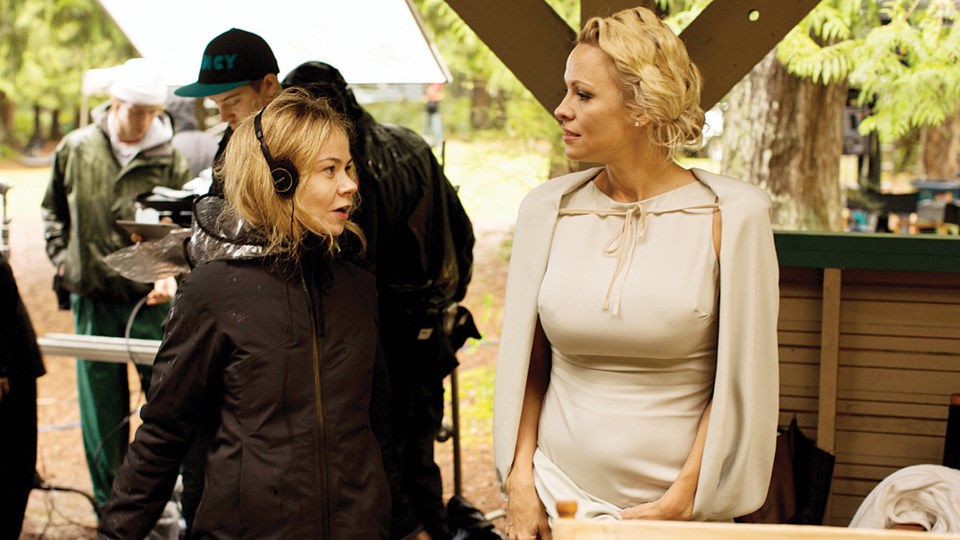The People Garden. Directed by Nadia Litz. Starring Dree Hemingway, Pamela Anderson and François Arnaud. Screening at Vancity Theatre as part of Canadian Film Week. For more information visit viff.org/theatre/series/canadian-film-week.
Would you cross an ocean and traverse a treacherous forest to see the one you love? Of course you would.
But what about someone you only used to love, someone who won’t answer his phone when you call, someone who leaves you stranded at the airport, someone who quite frankly needs to get dumped?
If she can’t find me, she can’t break up with me could be the premise of a Curb Your Enthusiasm episode; but steeped in the sad, surreal and sinister setting of Japan’s Aokigahara forest, The People Garden becomes something else.
Sweetpea used to be in love with a rock singer named Jamie, but now he’s a tie that must be cut. The cutting, however, isn’t so easy.
When Sweetpea (Dree Hemingway, great-granddaughter of writer and sporadic pugilist Ernest Hemingway) first arrives in Japan the movie feels like Lost in Translation directed by Sergio Leone.
Hemingway wanders in and out of broad vistas like a discombobulated Charles Bronson, searching for Jamie.
She ventures farther, getting into a car driven by a man she doesn’t know because the driver, Mak, says he knows where Jamie is.
He’s in a forest.
Located at the base of Mount Fuji, the Aokigahara forest is the place Japanese men and women are known to take their lives.
As she treks deeper we hear a faintly melodic ringing, like an alarm clock stuffed under two pillows.
The soundtrack and dream-like visuals will “hopefully haunt you,” says writer/director Nadia Litz.
Speaking from Buenos Aires, Argentina, hours before her movie’s premiere, the filmmaker downplays the notion Sweetpea’s quest mirrors her own life.
“I think every film has a bit of autobiography in it, but then at some point it becomes very much its own entity,” she says.
Sweetpea’s obsession for Jamie can be interpreted as how hard it is to reach someone, the labyrinthine nature of the human heart, or how hard it is to let someone go.
“When you finally make that decision and you’re ready to let someone go, it’s often the time when you’re drawn back into their orbit,” she says. “It’s almost as if she’s falling back in love with him as she’s trying to let him go. … There is humour in that.”
There’s tranquility as Sweetpea searches the forest, but never for long. Every time Sweetpea exits a room someone talks about watching her, what they’re really doing in the forest, or who they really are.
A young woman’s sojourn into a forest beyond imagination is reminiscent of Nathaniel Hawthorne’s Young Goodman Brown, in which a simple man finds himself bedevilled by a forest at night.
“The whole forest was peopled with frightful sounds -- the creaking of the trees, the howling of wild beasts, and the yell of Indians; while sometimes the wind tolled like a distant church bell, and sometimes gave a broad roar around the traveler, as if all Nature were laughing him to scorn,” Hawthorne writes.
Instead of Hawthorne’s creaks, howls and roars, Litz gives us a soundtrack courtesy of Dirty Beaches, a.k.a. Alex Zhang Hungtai, a Taiwanese-Canadian musician now living in Los Angeles. Hungtai, whose performing credits include David Lynch’s dinner parties, injects Sweetpea’s search with equal measures of menace and placidity.
We get a sense of Sweetpea but not necessarily an understanding. She dismisses the idea of breaking up with Jamie via text as barbaric, but we get the feeling her reasoning is as unlikely as Humphrey Bogart’s claim he came to Casablanca for the waters.
“She has this sense of mystery to her,” Litz says of Hemingway. “She’s a hard person to get to know but I recognized something in that, and I think it makes for the best actors because you know that there are layers you can mine.”
The movie attempts to combine dark humour with the gravitas of human emotion.
“You can’t live life and experience only one,” Litz says.
She started writing The People Garden more than five years ago, back when it would’ve been the first North American movie to deal with Aokigahara. In the meantime, both a horror movie and a Gus Van Sant drama have dealt with the infamous sea of trees.
“The horror film wasn’t really on our radar, but when we found out (about) Gus Van Sant,” Litz stops herself and laughs. “There isn’t a worst case scenario for an indie film. … Unless it was Sofia Coppola it couldn’t have been worse.”
The movie also features an unlikely turn by Pamela Anderson. Yes, that Pamela Anderson.
Signe (Anderson) is a sex symbol whose symbolism is waning. She tries to ward off looming irrelevance by comporting herself with a forced elegance, like a burlesque queen in exile.
Litz was motivated to cast Anderson after catching her appearance on The Ellen DeGeneres Show.
With the pixie haircut of a Godard muse, Anderson appeared on the show to discuss running the New York Marathon to promote a Haitian relief fund.
“She was speaking with such great intelligence and self-awareness and wit,” Litz recalls.
But at the end of the segment, Anderson changed out of her demure blouse into an almost see-through t-shirt and she was sprayed with water while running on the spot.
“As if to say, this is the only way we want to see Pamela Anderson run the New York Marathon,” Litz recalls.
That dismissive attitude fit with the idea of “wanting to transform in an environment that insists you stay the same,” she says.
The movie premieres at Vancity Theatre April 20. Bring a map.



